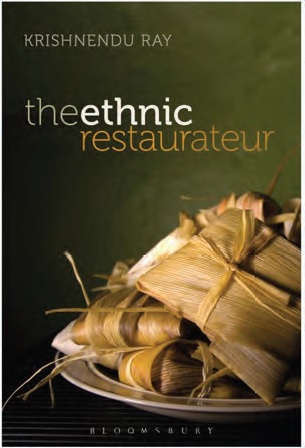|
Read 13149287 times
Connect me to:
|
The Ethnic Restaurateurby: Ray Krishnendu
London UK:
Bloomsbury Publishing Co. 2016, Hardbound
ISBN: 978-0-85785-836-8
Reviewed by: Jacqueline M. Newman
Spring Volume: 2017 Issue: 24(1) page(s): 20
 Not a cookbook,
this is a pathbreaking
contemporary view
of the American
culinary scene
mostly in New York
City public eating places, their chefs, restauranteurs,
and culinary consumers. It shows migrants becoming
established in new places and play important roles
influencing their home and adopted food cultures. One
sees them impacting newspaper reporting and guide
books, their toil, tastes, and ethnicity making for what
is eaten in the places they work and those they own, but
less than one might imagine.
Not a cookbook,
this is a pathbreaking
contemporary view
of the American
culinary scene
mostly in New York
City public eating places, their chefs, restauranteurs,
and culinary consumers. It shows migrants becoming
established in new places and play important roles
influencing their home and adopted food cultures. One
sees them impacting newspaper reporting and guide
books, their toil, tastes, and ethnicity making for what
is eaten in the places they work and those they own, but
less than one might imagine.
In 1980, for example, Chinese, Italians, and Mexicans
were nearly seventy percent of restaurant workers,
but did not account for anywhere near that amount of
ethnic foods consumed in the US. Khrishnendu discusses their haute aspirations and
restaurants they own and/or work in. He looks back to
recorded restaurant beginnings in the 1850s when many
had few Chinese staff. Their occupations were first
recorded from that year. Now there are more correlations
between ethnicity of food service workers and foreignborn
restaurant cooks, an item slow to change. The author, from the Indian sub-continent, reports
that since the Civil War, French, German, and Chinese
restaurant workers were most discussed in newspapers
and Zagat-rated eateries. After 2010, there are almost
four million Chinese in the US that now own more
Chinese restaurants than all McDonald, Burger King,
and Kentucky Fried Chicken eateries combined. Their
eateries grow quickly with more Chinese restaurants
growing more quickly than other eating places. Lots of Chinese restaurants serve food that did not
originate in China such as alligator Chinese style and
a Chow Mein Sandwich, both unknown in China. Most
Chinese restaurant workers, some half million in the
past decade, came from the Fujian Province and the
south of China; they are not serving nor touting these
foods. The two oldest food service worker populations in the
US are Chinese and Mexican, most not serving Chinese
nor Mexican foods they know best. Thanks to people
such as Misa Chang both of these populations have
redefined many parts of the places they work in or
own, and include take-out and delivery of their mixed
culinary offerings. They are not represented by the less than twelve percent
of James Beard awardees who are female, yet the more
than that percentage are females in the restaurant
industry. There restaurant foods are a culinary mix,
their work experiences and food memories further from
the foods that their ‘tastes of home.’ There is robust sociology literature about ethnic
entrepreneurship and correlations between food
service workers, new immigrant groups, and how their
foods move to new eateries. Ray does report that most
restaurant cooks are foreign born, do not serve the
foods of the countries they came from. As one example,
Queens County in NY has many Asian cuisines and in
2014 the Chinese were the largest population among the
sixty-one different ones reported working there. There
are almost four million Asians living in the US while
French food this city’s most expensive, far from the one
most often served. Chinese cuisine is the second most
frequently consumed foreign food, Italian served most
often. There are very few French living in this city, few
French restaurants, and no relationship between price,
availability, and these populations. |

 Not a cookbook,
this is a pathbreaking
contemporary view
of the American
culinary scene
mostly in New York
City public eating places, their chefs, restauranteurs,
and culinary consumers. It shows migrants becoming
established in new places and play important roles
influencing their home and adopted food cultures. One
sees them impacting newspaper reporting and guide
books, their toil, tastes, and ethnicity making for what
is eaten in the places they work and those they own, but
less than one might imagine.
Not a cookbook,
this is a pathbreaking
contemporary view
of the American
culinary scene
mostly in New York
City public eating places, their chefs, restauranteurs,
and culinary consumers. It shows migrants becoming
established in new places and play important roles
influencing their home and adopted food cultures. One
sees them impacting newspaper reporting and guide
books, their toil, tastes, and ethnicity making for what
is eaten in the places they work and those they own, but
less than one might imagine.